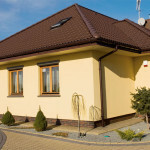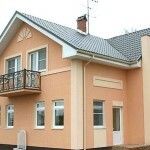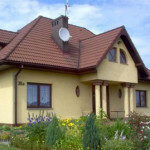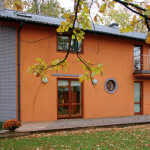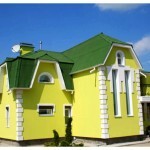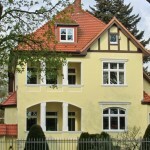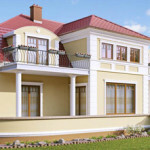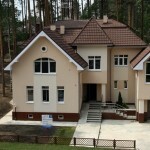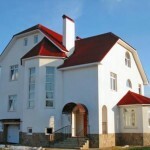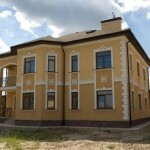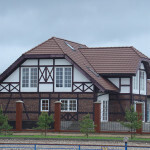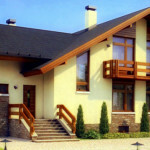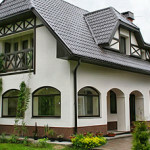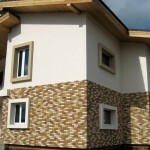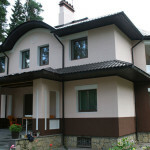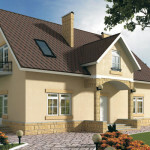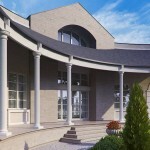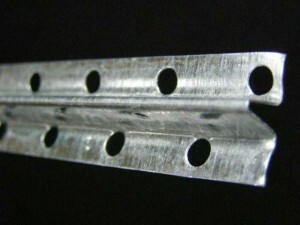Facade plaster (36 images) technology application, species, especially acrylic, mineral, silicate and silicone compounds
Table of contents
-
1 Types of plaster for facade
- 1.1 acrylic
- 1.2 mineral
- 1.3 silicate
- 1.4 Silicon
- 2 infliction
- 3 Summing up
- 4 Photo Gallery
Now instead of the usual plastering all insulating facade system increasingly used. To the wall using fasteners and adhesive material is attached to insulate mineral (basalt) wool, then - reinforcing mesh.
The cover layer is a special exterior plaster - application technology it is fairly simple.

Types of plaster for facade
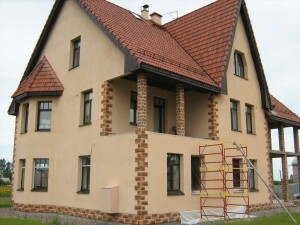
On the photo front of the house, lined with acrylic plaster
Benefits:
- Protect the walls from moisture but air-permeable.
- Enable the production of a variety of surface structures due to fillers and processing methods.
- Materials with special fillers improve heat and sound insulation of the walls.
- Allow in the future to change the color of the facade cladding.
Modern industrial materials are divided into four types:
acrylic
Available already ready to use. The materials of this type renders the binder is an aqueous acrylic resin dispersion which provides a coating ability to pass pairs
The walls of the building, which have steam-power, give the excess moisture penetrating into them. This significantly reduces the probability of wetting the interior, due to condensation of water vapor therein. If moisture does happen, it can be quickly eliminated.
Acrylic mass has elasticity and resistance to temperature extremes. Due to its low absorption property, coating contamination are not structural, so can be easily removed. Biocidal additives protect the acrylic coating from destruction by microorganisms.
mineral
Due to binder (cement or lime) mineral coating are among the most durable thin façade plasters. Mineral materials are available in the form of a dry mixture of binder, filler-crumbs and various additives that reduce permeability.
This coating is well protected from microbial and mold growth. The main drawback - limited choice of colors, the price - from 530 rubles ..
silicate
It is one of the varieties of mineral plaster. A binder in her favor liquid potassium glass. As with previous materials, silicate coatings are available ready-to-use.
The main advantage of this cladding material - high vapor permeability capacity. It allows you to use it where it is impossible to apply the acrylic coating, for example, on the walls of cellular concrete.
Silicate mass has a neutral electrical charge, are not attracted to the environment of dust and dirt particles.
Silicon
The most expensive type of facade coatings. It is based on polymeric binders. This material has many advantages, can be painted in a variety of colors, has elasticity and high vapor permeability.
Interesting fact! In such a lining is one feature - it is self-cleaning. Rainwater quickly washes her dirt and dust.
Is selected form the basis of the type and characteristics of the facade, as well as your preferences. Methods of application and to create textured plaster structure for all thin industrial plasters same.
More often than not carried out rough and rustic texture. When playing the rough texture of the material is overwritten moves in a circle. If done rustic, voluntary movements (vertical, horizontal, circular) depending on the desired result.
If you want to get the texture of plaster like sandstone, used mineral mass, which is composed of limestone and quartz fillers factionalism to 1 mm. With this fine crumb structure of the coating is obtained similar to the stone.
infliction
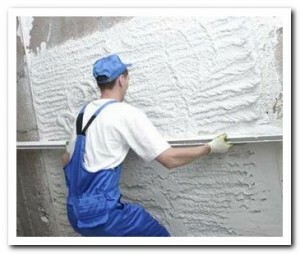
by weight Leveling Guide
If the creation of a thermal insulation layer is not expected, the first step in preparation of the walls. Remove the old, poorly adhering plaster (if any).
If the walls are folded piece of material - bricks, blocks, stones, clean seams to a depth of 1 cm.
Take on the facade of the expansion joints in steps of 2.5-3 m. They will increase the coupling, prevent shedding and cracking of the lining.
Then obespylte and moisten the surface of the walls.
The second stage - preparing a mixture. Before you prepare a solution for plaster, read on the package, in what proportion shuts dry composition, as well as pay attention to the time of production.
The third stage - directly plaster walls outside the building by the rendering. This operation requires a certain skill, since it is necessary to throw on the wall surface is an amount of the mixture that is required at this site. This should be done with such sharpness and strength to weight stuck to the wall rather than glass or sprayed down the sides.
Facade plaster with your hands should be applied taking into account several nuances:
- Work on the construction of the wall can not be fresh, since shrinkage of masonry coating will crack.
- In concrete walls can not be directly applied to the solution containing gypsum. Decorating can swell, and then get behind the wall. To avoid this, apply lime plaster first wall is 5 mm thick.
- Grout do in a few hours after the smoothing weight when it becomes hard, but will not have time to fully grasp.
- The layer thickness which is applied at one time should not be more than 2 cm.
Note! Overwrite the surface should be wooden or aluminum (with bonded foam) trowel, pressing her whole plane to the surface and performing a circular motion.
Summing up
We hope that our material has been useful for you. We can only wish you good luck and offer to view the video in this article.
Photo Gallery
